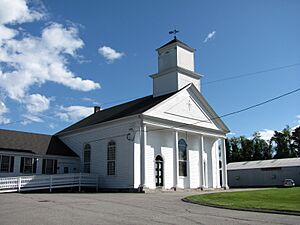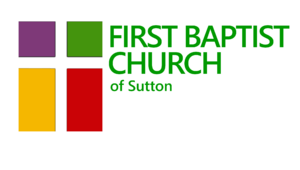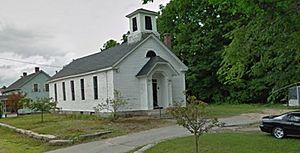First Baptist Church of Sutton facts for kids
|
First Baptist Church of Sutton
|
|
|
U.S. Historic district
Contributing property |
|
|
U.S. National Historic Landmark District
Contributing Property |
|
| Location | Sutton, MA |
|---|---|
| Nearest city | Worcester, MA |
| Built | 1829 (1959 Hall) |
| Architect | Samuel Waters (Sanctuary) & Rae Johnson (Hall) |
| Architectural style | Greek Revival |
| Part of | West Sutton Historic District |
| NRHP reference No. | 01000871 |
Quick facts for kids Significant dates |
|
| Added to NRHP | August 8, 2001 |
| Designated NHLDCP | August 8, 2001 |
The First Baptist Church of Sutton is a historic Baptist church located in Sutton, Massachusetts. It was started on September 9, 1735, by Reverend Benjamin Marsh and Thomas Green. They were also important in founding the town of Sutton. This church is the fourth oldest Baptist church in Massachusetts.
The First Baptist Church of Sutton has been active almost continuously since 1735. There was a short break during the war years from 1775 to 1785. Over the years, the church has had three main buildings. The first was built in 1750 near where Sutton High School is today. The second building, from 1792, was where the police and fire departments are now. The third and current building was built in 1829 on Central Turnpike. This building is part of the West Sutton Historic District. A new Fellowship Hall was added in 1959. The main church building shows the Greek Revival architecture style, which was popular at that time.
The church has strong ties to many old families in Sutton. These families include names like Putnam, Davis, King, and Sibley. Today, the First Baptist Church is part of the North American Mission Board's effort to help churches grow in New England. The church has been known by several names over time, including Legacy Church and The Frontier Church.
Contents
A Look Back: The Church's History
Starting in the 1700s
The First Baptist Church in Sutton officially began on September 19, 1735. Before this, James Bound had already gathered a group of Baptists in town. In 1737, Benjamin Marsh and Thomas Green became the church's first co-pastors. Thomas Green later left to start a new Baptist church in Leicester.
Reverend Marsh led the First Baptist Church for over 40 years. This is still the longest time anyone has served as pastor. During his time, the church grew a lot, especially because of the Great Awakening. The first church building was put up in 1750. It was located at the corner of Hutchinson and Boston Roads. The second building was built on Freeland Hill. This one did not have a steeple or a bell. Later, this second building was moved and now serves as the home of the Sutton Historical Society.
After Reverend Marsh passed away, the church faced some challenges due to the wars in America. However, members reorganized the church in 1785. In 1792, Reverend William Batchellor helped start the Second Baptist Church in South Sutton.
Growing in the 1800s
The church played an active role in Sutton's 100-year anniversary celebrations. Under Reverend Samuel Waters, the church grew to more than 100 people. The second building became too small for everyone to fit in one service. So, the church members decided to raise money for a new, larger building.
The third and current church building was finished in 1829. It was built in a more central spot in West Sutton. This new building could hold 250 people and included a balcony for the choir. It was officially opened on September 16, 1830. The building's front looks like a Greek Revival temple. This style was very popular for churches in the early 1800s. The steeple was designed in the style of Christopher Wren. The church's beautiful old bell was made in 1829 in Medway, Massachusetts. It was one of the first church bells cast in the United States.
In the 1890s, the old choir loft was closed, and the doors on the pews were removed. Only one of these original pews from 1829 remains today. The 1800s saw many different pastors, some of whom were older and retired during their time. The American Civil War also affected the church. Three different men served as pastors around the same time because they were also serving in the Union Army. The church had to close on and off during the war years. During these times, the church elders led the services.
Changes in the 1900s
During Sutton's 200-year anniversary celebrations in 1904, Reverend Arthur Davis represented the church. For many years, different houses in West Sutton were used as homes for the pastors. In 1915, the church bought a large house nearby to be its permanent parsonage.
In 1929, the church celebrated 100 years since its current building was constructed. A basement was dug under the church to make space for a furnace. This meant the two large wood stoves could be removed. The inside of the church was also redecorated. Electric lights were installed to honor Mr. C.S. Jones, a member of the Men's Sunday School Class.
A group called "The Hillside Club" was formed in 1906. This women's group helped the church financially and supported the community. They often raised extra money when needed. In 1950, they spent money to improve the Community Hall and help with redecorating the church. A Christian Endeavor Society was started in the 1890s, stopped for a while, and then restarted in 1936. This group was very important to the church and community.
New pews were bought for a new choir section, but they did not match the church's interior. A maroon velvet curtain was used to cover this area. The church held services on Sunday evenings as well as mornings. In 1938, a hurricane blew down parts of the steeple, damaging other parts of the building. The men of the church capped the second section of the steeple. They also started a fund to build a new spire.
In 1938, the church bought the large two-story building next door. This building became a parish house and community hall. It had been an old country store and post office for many years. It was improved and modernized for church and community use. In 1949, the first well was drilled, providing water for the church, parish hall, and parsonage. A new organ was given to the church in 1910 and later electrified in 1948.
In 1950, the church began a big project to re-plaster and paint the entire inside. Money was raised through auctions, suppers, movies, and a bazaar. Church members and community volunteers cleaned and painted the pews and floor to save money. They found that the pews had solid mahogany trim, which was restored. Beautiful maroon velvet curtains were installed in the choir area and at the windows. In 1950, the church had sixty-three members. A new hall was added to the east side in 1959. This provided more space for the growing church, including classrooms. In the late 1990s, the main church area was updated again. The balcony and some pew areas were covered, reducing the seating capacity to about 180 people.
The 2000s and Today
The church was previously connected with the Triennial Convention and American Baptist Churches USA. In 2003, the church leadership decided to join the Southern Baptist Convention. This happened through the Baptist Convention of New England.
Behind the church, there is a baseball field and a basketball court. These were used by the town for many years. In 2004, the church replaced its old wooden sign with a new lighted one that could display messages. The fellowship hall has also been used by many local groups. These include a gun club, police and fire unions, a flower club, and Alcoholics Anonymous.
Reverend Edward Pentland retired in June 2017. In April 2017, Reverend Donald J. McKinnon became the new pastor. In 2017, the church started using the internet and social media more. They launched their own website, Facebook, Twitter, and Instagram pages. They also started using the #ForSutton hashtag. The church recently rejoined Sutton's Sutton Chain of Lights Christmas celebrations.
Pastors
The First Baptist Church of Sutton has had many pastors over its long history. Here are some of them:
- Benjamin Marsh, 1735–1775 (40 Years, the longest serving pastor)
- Thomas Green, 1735–1737 (2 Years)
- Ebenezer Lamson, 1785–1794 (9 Years)
- William Batchellor, 1794–1799 (5 Years)
- Samuel Waters, 1799–1825 (26 Years)
- Edward J. Pentland, 1997–2017 (20 Years)
- Donald J. McKinnon, 2017–Present
Images for kids






